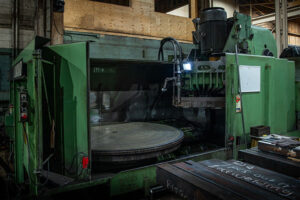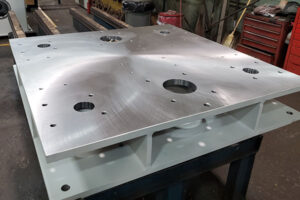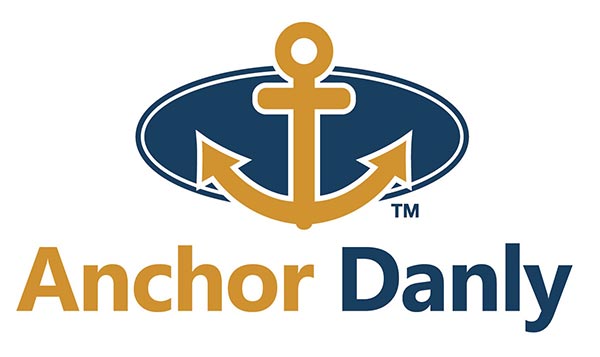1045 Steel – medium carbon type, typically used in machine parts. 1045 steel is easy to heat treat, has moderate weldability and high strength.
4140 Steel – chromium-molybdenum alloy steel has good machinability and is abrasion resistant.
Adapter plates – a plate that lets a manufacturer connect two OEM subcomponents from separate manufacturers that may be different sizes.
Quick Change Adapter/Locator Plates – allows the change out of tools for production in a timely cost effective manner eliminating production down time.
Aluminum bronze – used in bearings and gears, these are copper-based alloys that offer high strength and are resistant to corrosion.
Aluminum die sets – tooling that contains a precision die that is constructed of a lightweight metal, lighter and less expensive than tool steel.
Ball bearing – in a die set, ball bearings reduce friction and extend tool life, reduce noise
Ball Bearing Guide Pin – a guide pin system comprised of a ball cage, ball bearings and bushings that allow the pins to ride a series of ball bearings to reduce friction and allow the press to operate at faster speeds.
Ball Cages – a device or sleeve which captures spheres, that reduce noise, and extend tool life. A ball cage is typically used in a die set in the manufacturing industry.
Blanchard Grinders – a metalworking machine used for a specific kind of grinding that uses a magnetic chuck and leaves a telltale rotary grind pattern on a steel plate.
Blanchard Grinding – a type of rotary surface grinding performed by a machine with the same brand name (a Blanchard Grinder). Blanchard grinding machines utilize a magnetic chuck and rotate plate steel while grinding the surface of a large piece of steel. Blanchard grinding leaves a shiny distinct pattern on a steel table top.
Bolster plates – used in the press industry a bolster plate is typically used with die sets and die set component industry. A bolster plate is used for quick tool changes within the industry. Bolster plates feature T slots and the plate itself is manufactured from carbon steel. It is also called a Ram or Ram plate.
Build to print – the build of a machine, weldment or other structure from a blueprint drawing and BOM Bill of Materials, i.e. there is no design element in a BTP job.
Burn and grind plate – Cutting steel via CNC technology utilizing a plasma torch is often referred to as “burn and grind”.
BOM – Bill of Materials is a detailed list of raw materials that go into making a product.
Build to order – a product is produced when confirmation from the buyer is confirmed.
Carbon steel plate – A commonly used material for manufacturing, containing iron and carbon low carbon content is referred to as mild, also available in medium and high carbon.
CNC burning – also called flame burning, a CNC controlled flame cutting system or machine to accurately cut steel using plasma energy or a flame.
CNC – an acronym for Computer Numerical Control. The automation of cutting tools by using a computer. Examples are lathes, mills, and grinders.
CNC machining center – a general term to describe a milling machine or drilling machine with an automated drill changing feature used in metal removal applications often in the metal machining industry.
Dial table – also called a precision dial table, is a type of automation where a round steel plate indexes in an assembly operation surrounded by robots or other pick and place devices.
Die – a precision tool that cuts or forms metals or alloys into shapes. Dies can form, pierce, bend, cut, shape, extrude or stamp metal. A die set is composed of two halves that fit in a press that generates adequate force to perform the required functions.
Die cam – often used in precision cutting, a die cam transfers the vertical motion and force into horizontal motion and force using a precision mechanical guidance system. Die cams must be made of tool steel metallurgically different from the die set to avoid a build up of friction and heat. Die cams are often fabricated from aluminum bronze.
Die lift rack – a mechanical system designed to lift, move, position and lower die sets in and out of position.
Die riser – A block or a plate used to adjust the height of a die set within a press.
Die springs – A high force capable compression spring used in a die set to absorb forces. Die sets are used in the manufacturing industry to contain a metal piercing tool in a press.
Die set – A die set consists of two flat ground metal plates that serve as mounting surfaces for all working die components. Each plate contains either a guide pin or bushing that maintains perfect plate alignment. This alignment is crucial because all the working components mounted on the upper and lower plates must interface with proper, precise clearances.
Die set sub plates – allows dies of different sizes to be mounted on a common plate. This allows for quick die changes. Subplates allow for dies to be prestaged ready for production while another subplate is operating in the machine which reduces downtime and increases productivity.
Die storage block – this device lifts the die set off the shelf or ground to avoid damage to the tooling.
Drill rod – round metal bar stock made from tool steel usually polished to a specification, usually supplied unhardened.
Dwell – the amount of time the press is required to maintain pressure to complete the operation cycle.
DWG – A binary format drawing file used in Computer Aided Design, CAD software. The format is used by Adobe, AutoCad software. DWG is an industry standard for 2 and 3 dimension design data information and exchange.
FOB – Free on Board is a shipping term to determine the delivery cost of a part, ie FOB our plant means that the component is being picked up at the manufacturers plant and there is no added cost for shipping.
Fabrication – constructing a base unit from component parts.
Ferromagnetic – the property of certain materials that show the propensity for magnetism, such as iron.
Flatness – a form control tolerance that is measured relative to itself; all the measurements along the plane of the steel plate or surface must be within a specified tolerance level to be considered flat.Flatness is important for parts that must wear evenly, such as gears, or for parts that will be mounted flush to another part.
Friction Pin – type of guide post that are precision-ground to a smaller inside diameter to the guide bushing. They prevent the die shoes from moving side to side.
GD&T – Geometric Dimensioning and Tolerancing. A system of symbols used to design and communicate engineering tolerances and dimensions.
Grinding – a process of removing metal with an abrasive material, usually a disk or belt or a dedicated machine, such as a Blanchard Grinding machine.
Ground flat stock – a metal alloy such as copper, steel or aluminum finished to a desired dimension.
Guide post – also referred to as guide pins or guide blocks, act to align the upper and lower die shoes precisely. They can be either friction pin or ball bearing style.
Heat treating – the process of heating steel to strengthen its properties, and keep its dimensional properties intact.
Heel Blocks – steel blocks that are precision-machined, and attached to the upper and lower die shoes. They prevent one-directional side thrust that can cause misalignment in cutting and forming operations.
Keepers – manufactured from high tensile strength steel, this tool is used in parallels to keep dies in place in the vice jaws during press operations.
Machine Base – a custom built weldment designed and manufactured of tubular steel that supports automation, robotics, and associated automated devices, often called a frame, table or a platform.
Machining – the manufacturing process of removing material from a substrate such as metal to create a tool or a plate by cutting. Machining is usually performed with a CNC (machine), a lathe or mill (milling machine).
Mastercam Software – a proprietary software application for CAD and CAD/CAM and used in the metalworking industry. The software was built by CNC Software, LLC.
Metal Working – the act of shaping metal objects for use in other parts or devices such as tools, structures, molds, weldments.
Mild Steel – a ferrous metal made from iron and carbon.
Mold – in the manufacturing industry, a mold is a tool manufactured of two metal parts, with cavities and features that create a part such as a plastic component from a molten liquid substrate.
Multi-platen die sets – a die set typically has a top and bottom, but multi-platen die sets can have 3-5 plates.
NAAMS – an acronym for North American Automotive Metric Standards
Nitrogen Gas Spring – a spring which features compressed nitrogen gas to exert force within a die. Nitrogen is able to store additional energy and is used instead of mechanical springs.
Parallels – components made of steel also called riser blocks are used to adjust the height of a die set within a press tool.
Parallelism – a form control tolerance measured relative to a datum or fixed base. It is essential for parts that must move in sync with other parts seamlessly.
Pedestal – a welded frame that raises a robot to a desired height for usability and service.
Plate – also called plating, which is a finishing process adding metal to a surface. Examples of plating are electroplating or vapor deposition.
Plasma Cutting – using a precision flame accelerated hot plasma to cut steel.
QDC – Quick die change plates are accessories to enable a faster die changeout.
Risers – steel parallels and riser blocks are used to adjust the height of a die set within a press tool.
Robot base – a table that supports a robot, usually fabricated from tubular welded steel and blanchard ground steel table top. The table adds stability and rigidity to the automation.
Tool – a device that carries out a particular task. A hammer or screwdriver are examples types of tools.
Shank – The straight or narrow part of a tool.
Shot blasting – also known as abrasive blasting, a technique to clean metal with a stream of high pressure material to clean a substrate, like steel plate.
Shunt Height – This is the distance between the top of the die and the top of the bolster plate (also called the Ram).
Stamping Press – A metalworking machine that uses force and a die to transform metal by cutting, bending and shearing.
Steel fabrications – components added to a steel subcomponent to create something of more value. A table base made of steel is referred to as a fabrication.
Steel hardening – to make steel hardened it should be heated to high temperature.
Steel plate – a plate of metal to be transformed by machining into a sub-component, table, tools etc.
Steel plate suppliers – a company, such as Anchor Danly that inventories and re-sells flat plate, steel and often will cut, grind and add other value such as heat treating and blanchard grinding.
Stress relieving – removing residual stresses in metal products by increasing the temperature of steel plate to protect against further dimensional changes.
STEP – a type of ASCII structure digital design electronic file used to exchange CAD information often used in manufacturing also see ISO 10303-21.
Tool Steel – a flat bar made from a type of carbon alloy steel.
Torch Cutting – also called flame cutting, an Oxygen fueled torch cutting is a method to efficiently cut metals and aluminum.
Wear Plates – a steel cut material designed to reduce stress, wear and tear on other sub components.
Weldment – a part or structure created by welding smaller parts together.



